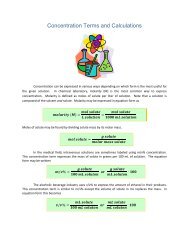Orgon's Obsession in Moliere's Tartuffe
Orgon's Obsession in Moliere's Tartuffe
Orgon's Obsession in Moliere's Tartuffe
You also want an ePaper? Increase the reach of your titles
YUMPU automatically turns print PDFs into web optimized ePapers that Google loves.
19<br />
Viewpo<strong>in</strong>ts Fall 2010<br />
of the K<strong>in</strong>g’s guard is sent to tell Orgon that the K<strong>in</strong>g has pardoned him and will restore his<br />
wealth and property due to Orgon’s prior service, fight<strong>in</strong>g loyally for the K<strong>in</strong>g <strong>in</strong> the civil wars.<br />
Moliere uses the appearance of the K<strong>in</strong>g at the end of the play to further emphasize that <strong>in</strong> the<br />
end, loyalty will be rewarded and betrayal punished.<br />
Many critics, however, see the <strong>in</strong>troduction of the K<strong>in</strong>g as an artificial means of external<br />
resolution. In “Dramatic Justice <strong>in</strong> <strong>Tartuffe</strong>,” Elsa V<strong>in</strong>eberg states,<br />
The K<strong>in</strong>g’s justice, it is argued, may be thorough and effective, but it is so unexpected<br />
as to cast doubt upon the dramatic coherence of the entire comedy. Probably, Moliere<br />
himself is responsible for this reaction, hav<strong>in</strong>g resorted to a deus ex mach<strong>in</strong>a that<br />
appears to defy <strong>in</strong>ternal resolution. By rely<strong>in</strong>g on a device which <strong>in</strong>troduces a new<br />
character possessed of sweep<strong>in</strong>g powers, he seems to be say<strong>in</strong>g that there is a break<br />
between dramatically motivated expectations of justice and the K<strong>in</strong>g’s own dazzl<strong>in</strong>g<br />
display of power and omniscience (V<strong>in</strong>eberg 583).<br />
Hav<strong>in</strong>g the K<strong>in</strong>g resolve everyth<strong>in</strong>g <strong>in</strong> his grand and powerful manner was seen by many <strong>in</strong> the<br />
seventeenth century and by critics today as Moliere’s appeasement of the aristocracy and the<br />
K<strong>in</strong>g himself <strong>in</strong> the hope of lessen<strong>in</strong>g the st<strong>in</strong>g of his satirical portrayal of religious hypocrisy.<br />
The K<strong>in</strong>g, <strong>in</strong> his wisdom and fairness, epitomizes the values of the age of reason.<br />
Moliere’s <strong>Tartuffe</strong> wrestles with issues of reason, irrationality, and obsession that we<br />
are still faced with today <strong>in</strong> 2010. Religious hypocrisy, as well as political hypocrisy, pervades<br />
our whole society, and <strong>in</strong> some form, presents itself <strong>in</strong> the news every day, often motivat<strong>in</strong>g<br />
contradictory and dangerous actions. We encounter so many false prophets and leaders <strong>in</strong> all<br />
sectors of our culture, and it is often difficult to tell the s<strong>in</strong>cere and genu<strong>in</strong>e from the masked<br />
and deceptive. We should still look for the simple virtues advocated by Moliere through the<br />
character of Cleante and always be will<strong>in</strong>g to look for the truth beh<strong>in</strong>d the facade.








